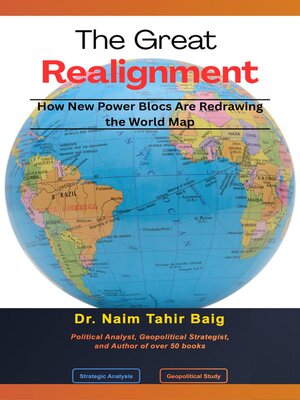
Sign up to save your library
With an OverDrive account, you can save your favorite libraries for at-a-glance information about availability. Find out more about OverDrive accounts.
Find this title in Libby, the library reading app by OverDrive.



Search for a digital library with this title
Title found at these libraries:
| Library Name | Distance |
|---|---|
| Loading... |
The Great Realignment: How New Power Blocs Are Redrawing the World Map
A groundbreaking analysis of the most significant transformation in global politics since the end of the Cold War
In January 2025, when Indonesia became the tenth member of BRICS+, the world witnessed the completion of the most dramatic expansion in modern international relations. What began as an economic partnership among five emerging economies had evolved into a coalition representing nearly half the world's population and 41% of global GDP. But this was not just another diplomatic milestone—it marked the emergence of an entirely new model of international cooperation that is fundamentally reshaping global power dynamics.
From China's DeepSeek AI breakthrough that shattered assumptions about technological containment, to the proliferation of "minilateral" partnerships like AUKUS, I2U2, and the Quad, traditional notions of alliance and opposition are giving way to a complex web of overlapping partnerships where strategic autonomy trumps ideological alignment.
It examines how countries like India successfully participate in partnerships with both the United States and China, how Turkey balances NATO membership with Shanghai Cooperation Organization engagement, and how Indonesia joined BRICS+ while maintaining defense cooperation with Australia and the United States. This is not the either-or diplomacy of the Cold War, but a new era of "minilateral proliferation" where nations maintain independence through diversified engagement rather than exclusive commitments.
Drawing on extensive research, diplomatic sources, and firsthand analysis of current developments through August 2025, Dr. Baig provides the definitive account of how BRICS+ expansion, technology competition, African strategic awakening, and Middle Eastern realignments are creating a multipolar world that defies traditional categorization. He reveals how concrete partnerships are delivering results—from AUKUS submarine construction to I2U2's $2 billion in renewable energy investments—while traditional multilateral institutions remain paralyzed by outdated governance structures and conflicting interests.
This is not a story of East versus West or democracy versus authoritarianism, but of pragmatic countries pursuing national interests through innovative partnerships that cross traditional ideological and geographical boundaries. Brazil leads BRICS+ while deepening energy cooperation with the United States. The UAE participates in both BRICS+ and I2U2 with Israel. Saudi Arabia balances new partnerships with traditional security relationships. These are not contradictions but strategic choices that reflect twenty-first-century realities.
Key insights include:







